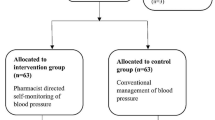Abstract
Fifteen hypertensive patients were recruited from a geriatric medicine clinic for a “research project designed to evaluate a Behavioral Stepped-Care treatment program of high blood pressure (HBP).” All patients met the selection criteria of the Isolated Systolic Hypertension (ISH) in the Elderly (SHEP) clinical trial. During baseline, subjects recorded BP at home 9 times/day (3 times each, shortly after awakening, during the middle of the day, and within an hour of retiring) for 1 month and mailed that data to us daily. In addition, they came to the clinic weekly and had their BP recorded by a nurse. During treatment 1, systolic (SBP) feedback, they were trained to lower SBP at home using their sphygmomanometers. They also continued to monitor BP and to obtain weekly professional BP readings. During treatment 2 (relaxation), they were trained to relax; they followed the self-administration and data-collection protocol as in treatment 1. Each treatment phase lasted 3 months. Average monthly self-determined BP fell significantly from 166.4/85.8 (SBP/DBP) mm Hg during baseline to 153.3/81.2 by the end of the relaxation phase; average monthly professionally measured BP fell significantly, from 164.7/87.1 to 156.9/81.5. These findings show that a nurse-supervised, patient-administered behavioral treatment program of ISH can yield sustained, significant falls in BP.
Similar content being viewed by others
References
Engel, B. T. Gaarder, K. R. & Glasgow, M. S. (1981). Behavioral treatment of high blood pressure I. Analyses of intra- and interdaily variations of blood pressure during a one-month, baseline period.Psychosomatic Medicine, 43 233–270.
Engel, B. T., Glasgow, M. S., & Gaarder, K. R. (1983). Behavioral treatment of high blood pressure: III. Follow-up results and treatment recommendations.Psychosomatic Medicine, 45 23–29.
Forette, F., de la Fuente, X., Golmard, J. L., Henry, J. F., & Hervy, M. (1982). The prognostic significance of isolated systolic hypertension in the elderly. Results of a ten year longitudinal survey.Clinical Experiments in Hypertension, 4 1177–1191.
Franklin, S. S. (1983). Geriatric hypertension.Medical Clinics of North America, 47 395–412.
Frohlich, E. D., Gifford, R. W., Jr., Horan, M. I., Kaplan, U. M., Maxell, M. H., Payne, G., Rocella, E. J., Shapiro, A. P., Weiss, S., & Bowler, A. E. (1986). Nonpharmacologic approaches to the control of high blood pressure.Hypertension, 8 444–467.
Gifford, R. W., Jr. (1982). Isolated systolic hypertension in the elderly. When-and-if-to treat.Postgraduate Medicine, 71 44–53.
Gifford, R. W., Jr., Furberg, C. D., Ostfeld, A. M., Perry, H. M., Jr., Schnaper, H. W., Rocella, E. J., Bowles, A., & Gillen, F. W. (1986). Statement on hypertension in the elderly.Journal of the American Medical Association, 256 70–74.
Glasgow, M. S., & Engel, B. T. (1987). Clinical issues in biofeedback and relaxation therapy for hypertension: Review and recommendations. In J. P. Hatch, J. G. Fisher, & J. D. Rugh (Eds.),Biofeedback. Studies in clinical efficacy (pp. 81–121). New York: Plenum.
Glasgow, M. S., Engel, B. T., & D'Lugoff, B. C. (1989). A controlled study of a standardized behavioral stepped treatment for hypertension.Psychosomatic Medicine, 51 10–26.
Glasgow, M. S., Gaarder, K. R., & Engel, B. T. (1982). Behavioral treatment of high blood pressure II. Acute and sustained effects of relaxation and systolic blood pressure biofeedback.Psychosomatic Medicine, 44 155–170.
Hulley, S. B., Furberg, C. D., Gurland, B., McDonald, R., Perry, H. M., Schnaper, H. W., Schoen Berger, J. A., Smith, W. M., & Vogt, T. M. (1985). Systolic hypertension in the elderly program (SHEP): Antihypertensive efficacy of chlorthalidone.American Journal of Cardiology, 56 913–920.
Julis, S., McGinn, N. D., Harburg, E., & Hoobler, S. N. (1964). Comparison of various clinical measurement of blood pressure with the self-determination technique in normotensive college males.Journal of Chronic Diseases, 17 391–396.
Kannel, W. B. (1974). Role of blood pressure in cardiovascular morbidity and mortality.Progress in Cardiovascular Diseases, 17 5–24.
Patel, C., Marmot, M. G., & Terry, D. J. (1981). Controlled trial of biofeedback-aided behavioral methods in reducing mild hypertension.British Medical Journal, 282 2005–2008.
Author information
Authors and Affiliations
Additional information
Ms. Pearce and Dr. Burton were supported in part by the Johns Hopkins Academic Nursing Home Award, PO, AG04402, from the National Institute on Aging. This material was presented in part at the annual meeting of the Gerontological Society of America, November 1988, San Francisco.
Rights and permissions
About this article
Cite this article
Pearce, K.L., Engel, B.T. & Burton, J.R. Behavioral treatment of isolated systolic hypertension in the elderly. Biofeedback and Self-Regulation 14, 207–217 (1989). https://doi.org/10.1007/BF01000094
Issue Date:
DOI: https://doi.org/10.1007/BF01000094




